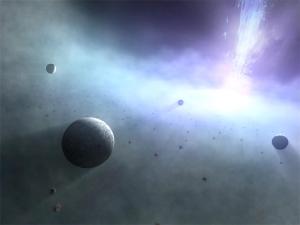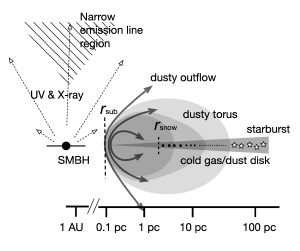Blog
Midnight Sun
25 November 2019
 Kagoshima University
Kagoshima UniversityImagine standing upon a barren world billions of light-years from Earth. In the sky overhead is not a brilliant Sun, but a supermassive black hole. While this seems like a scene out of science fiction, new research1 has found that such a “black hole world” could exist.
Planets commonly form around young stars. As a star is born within a stellar nebula, a disk of gas and dust forms around the star. Some of the dust in this disk clumps to form young planets, and over time the heat of the star clears the region leaving a system of exoplanets orbiting the star.
 Wada, et al
Wada, et alAccretion disks of gas and dust also form around supermassive black holes. For very active, quasar-like black holes, so much light and heat is produced that the accretion disk is too hot for planets to form. But for less active black holes, known as low-luminosity Active Galactic Nuclei (AGNs) a dusty torus of gas can form, similar to the protoplanetary disks around young stars.
A team recently looked at this idea and found that low-luminosity AGNs could provide their surrounding disks with just enough heat to allow dust particles to collide. Over time the clumps would form into planets that could be ten times more massive than Earth. How quickly planets could form is dependent on the mass of the black hole. For a black hole similar to the one in our galaxy, the timescale is on the order of 100 million years.
Based on their calculations, a supermassive black hole could have tens of thousands of planets orbiting it, several light-years from its event horizon. If that’s true, then supermassive black holes could be home to the largest planetary systems in the universe.
Of course, detecting these black hole exoplanets is impossible for now. They are too small and dim to observe using current instruments. But if they are out there, some clever astronomers will figure out a way to find them in time.
Wada, Keiichi, Yusuke Tsukamoto, and Eiichiro Kokubo. “Planet Formation around Super Massive Black Holes in the Active Galactic Nuclei.” arXiv preprint arXiv:1909.06748 (2019). ↩︎